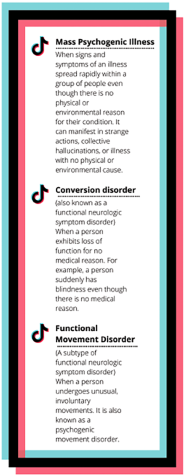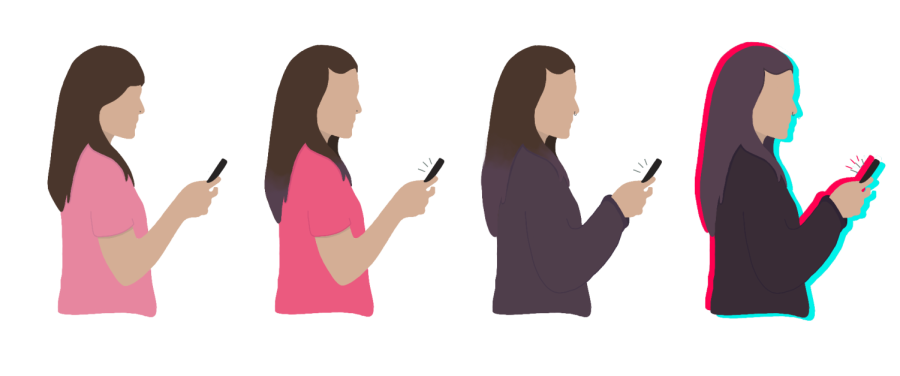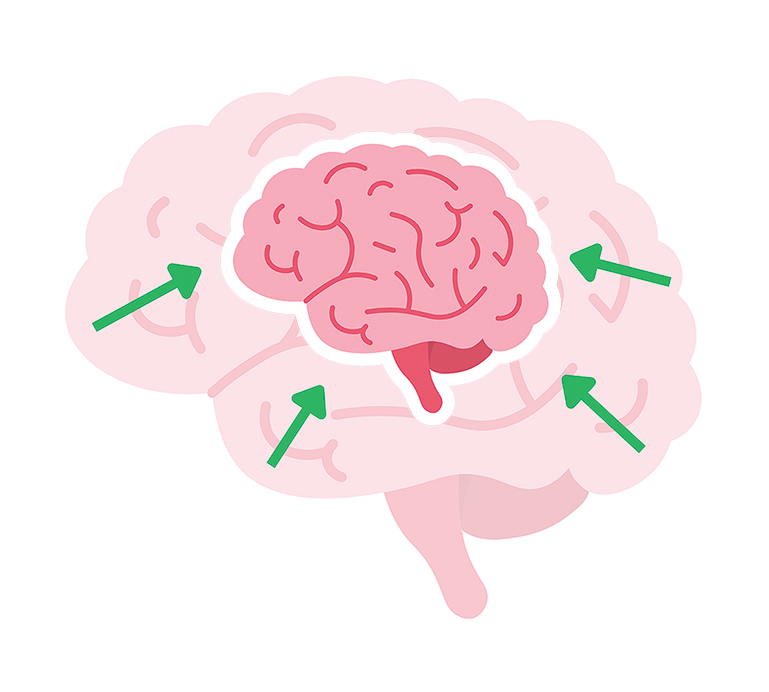Tik Tok Made Me Do It
Social media contributes to the spread of sociogenic illness and self diagnosing
March 31, 2022
In 1518 in Strasbourg, France, a woman named Frau Troffea began to dance uncontrollably. There wasn’t any music, but she continued to dance for almost an entire week without stopping. After a month, about 400 citizens of Strasbourg claimed that they, too, were infected with the sudden urge to dance. This would soon be known in history as the dancing plague of 1518.
The dancing plague became a town event. The town hired musicians and brought in professional dancers. However, it soon turned deadly. Dancers collapsed from exhaustion and some died from strokes or heart attacks. The dancing hysteria lasted from July 1518 to Sept 1518 and finally concluded when the town brought the dancers to a mountaintop shrine to pray.
The dancing plague of 1518 may sound like a tall tale, but at the time it was recorded and documented by many people. What’s even more strange is that this wasn’t the only city affected by a sudden “dancing plague.” Cities in Switzerland, Germany and the Netherlands had similar occurrences, though none were as large as Strasbourg.
What caused these events? Why did people dance themselves to exhaustion and, in some cases, death? Behavioral scientists are still unsure of the cause but they have given this phenomenon a name; Mass Psychogenic Illness (MPI).
In history, MPIs, previously known as mass hysteria, could only affect groups of people in close proximity. Today, social media has expanded the reach of MPIs to span the globe.
According to Stephanie Sutton, MD, a psychiatrist at the University of Nebraska Health Center, “Social media can affect the spread of functional movement disorders. According to UptoDate [A trusted online clinical resource that many physicians use], “Exposure to functional or organic movement disorders among friends and family (disease modeling) may be a risk factor for developing functional movement disorders. Social media can provide exposure through videos, descriptions, etc.”
Put simply, social media can provide increased exposure to movement disorders leading to increased transmission of these disorders.
This is not a new concept though. In 2013, sociologist Robert Bartholomew may have unintentionally predicted the future when he warned about the importance of social media’s role in mass psychogenic illness in an email interview with The Atlantic, saying there is “potential for a far greater or global episode, unless we quickly understand how social media is, for the first time, acting as the primary vector or agent of spread for conversion disorder.”
Since then, social media seems to have acted as a source for a global episode of MPI and conversion disorder.
For example, if you have social media, you’ve likely come across a video or post that has described symptoms of various illnesses or disorders. These posts can unintentionally cause harm, paranoia and lead people to self-diagnose without a medical professional.
That’s not to say that the videos can’t help. Some people see these videos and realize they should talk to their doctor about their concerns. In fact, one anonymous survey respondent at LSE believes social media can be a helpful resource.
“Social media is obviously not a place to go to be diagnosed, but it is a place where you can find some answers and entire communities of people who have the same problems,” the student said.
However, Chief Medical Officer at Valley Behavioral Health Dr. Todd Thatcher believes that using the internet to self-diagnose can be harmful and, in some cases, dangerous.
“If you jump to conclusions about the condition you’re suffering from, you may begin wrongful treatment,” Thatcher said. “With self diagnosis you also run the risk of being completely wrong about an illness you have, especially if the symptoms you are experiencing are common.”
In 2021, doctors started seeing a strange phenomenon. Many young people, predominantly girls, who had no history of Tourette syndrome or tics, had a sudden onset of complex motor and verbal tic-like behaviors and were presented to the ER for urgent assessment.
Dr. Tamara Pringsheim, an associate professor in the Department of Clinical Neurosciences, Psychiatry, Pediatrics, and Community Health Sciences at the University of Calgary, recalled seeing an unusual number of patients with tic-like behaviors in 2021.
“In approximately 70 percent of these cases, there was no prior history of tics,” Pringsheim said in an interview for Medscape Neurology. “The tic-like behaviors developed rapidly over the course of hours to days and the level of disability was extremely high, with many of these young people unable to attend school due to the severity of their symptoms and some even requiring hospital admission.”
Pringsheim soon found out that cases incredibly similar to the ones she was seeing were popping up all over the world. Yet, many of these cases were unlike typical cases of Tourette Syndrome. The typical onset of tics for children with Tourette Syndrome is around age 6, yet in these cases, the sudden onset of tics appears in people ages 12 to 25.
Another unusual thing about these cases is the gender distribution.
“We usually see three to four boys with Tourette Syndrome for every girl. In the rapid-onset cases, 95 percent of the cases we’ve seen so far are in girls or young women,” Pringsheim said, “I have seen six people in the past four weeks who are saying the same low-frequency word as one of their complex vocal tics. In the previous 20 years, I have not seen a single patient with this specific word as a tic.”
All of this is very uncommon, raising the question of what caused this sudden outbreak of identical tic-like behaviors amongst this group of people.
Pringsheim and other doctors started looking for a common cause that connected these cases. They discovered hundreds of videos posted by people with tics and tic-like behaviors on TikTok. Some accounts that posted these videos had millions of followers. Pringsheim believes that these videos may trigger tic-like behaviors for some of the viewers. She says this may be due to the occurrence of echophenomenon, the automatic imitative behavior in a group setting.
Pringsheim also believes social stress and anxiety from the pandemic could be another factor. Stress and anxiety can manifest in the expression of symptoms, as well as social and environmental reactions to symptoms. This could inadvertently reinforce or intensify the symptoms.
The mass occurrence of tic-like behaviors is a relatively new phenomenon, so there is still a lot to be learned. It is important to remember that people who have developed tic-like behaviors because of TikTok are not faking it or trying to get attention. They are experiencing a functional movement disorder, and it is genuine.
TikTok and its effect on young minds is a growing concern. In a press release on Wednesday, March 2, Nebraska Attorney General, Doug Peterson, announced his plans to co-lead an investigation on TikTok.
According to the press release, Peterson co-led a nationwide investigation into TikTok for “providing and promoting its social media platform to children and young adults while use is associated with physical and mental health harms. Attorneys General nationwide are examining whether the company violated state consumer protection laws that put the public at risk.”
The investigation will look at the damage TikTok has caused and what TikTok knew about it. It will also look at TikTok’s addictive algorithm and other techniques TikTok has used to increase viewer involvement.
Many state attorneys general are already helping lead the investigation. A bipartisan coalition of attorneys general from California, Florida, Kentucky, Massachusetts, Nebraska, New Jersey, Tennessee and Vermont are all involved in the investigation. They also have support from several other attorneys general in the United States.
It’s no secret that social media can negatively affect mental health, but we are just beginning to see the long-term impacts of social media on our behaviors and habits.










